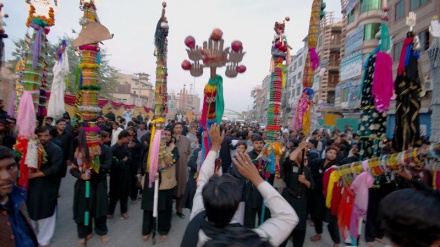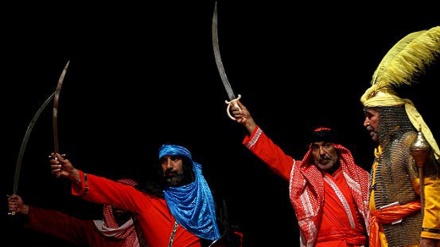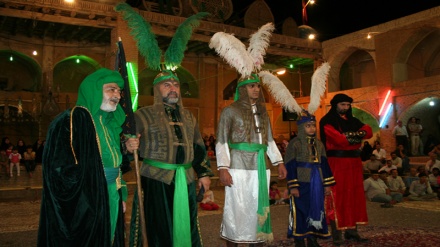Muharram mourning traditions in different lands - 30
Today we talk about the tradition of using chains to beat one’s back as a form of mourning for the martyrs of Karbala. Self- flagellation or beating one’s back using chains is very common in both Iran and many other Muslim lands during the mourning month of Muharram.
Throughout Iran during Muharram, groups of mourners in various processions flagellate themselves with chains as a form of mourning for the Chief of Martyrs, Imam Husain (PuH) and the other martyrs of Karbala. This tradition has been going on for many centuries, and mourners, chanting elegies and lamentations, in rhythm with the beating drums and cymbals, display their grief and devotion for history’s most heartrending tragedy. Mourners reciting elegies, and flagellating themselves with chains has been an important part of Muharram mourning for many centuries.
Normally, men, both old and young, as well as boys, form two parallel lines, and flagellate themselves with chains to the rhythm of the “Nowheh Khan” or reciter of elegies. It should also be noted that self-flagellation which results in bodily harm, or the deliberate release of much blood from the human body, is not permissible. This is important because in some countries chains fitted with blades are used in self-flagellation processions during the Muharram and Safar mourning ceremonies.
This practice is forbidden in Iran and, generally speaking, no blades are used in mourning ceremonies throughout the Islamic Republic, in line with the fatwa of the leading religious authorities. It is also true to say that those who flagellate themselves with chains do not wantonly harm themselves physically by deliberately allowing blood to come out from their backs and chests.
In view of this, we certainly don’t see in the flagellation processions in Iran, any blood flowing in the streets, horrifying onlookers, polluting the clothes, and distorting the philosophy of grief and mourning for Imam Husain (PuH).
Another important mourning ceremony associated with Muharram in the Islamic Republic of Iran is “the rotation of the palm tree”. This ceremony –which is called “Nakhl Gardani” in Persian – is observed in the central provinces of Iran, and is one of dozens of glorious ceremonies designed to keep alive the memory of the Martyrs of Karbala.
In particular this ceremony is held every Muharram in cities towns and cities such as Damghan, Khomein, Kashan, Abyaneh, Zawareh, Ardestan, Khour, Biyabanak, Naeen, and surrounding areas , as well as in the provinces of Qom, Southern Khorasan, Semnan, Isfahan, and most important of all, in the province of Yazd.
It is no exaggeration to say that in every city, town and village in Yazd province, you will find at least one, or more likely a few palm trees, which have been set aside specifically for Muharram mourning ceremonies and “rotation of the palm tree”.
During this ceremony mourners, dressed in black, carry the palm tree on their shoulders. Symbolically, the palm tree represents the sacrosanct and blessed body of the Chief of Martyrs, Imam Husain (PuH). Since on the day of Ashura, the Godless Omayyad hordes, who buried their own dead but did not allow the Prophet’s surviving family members to provide shroud to the Prophet’s grandson and the other martyrs of Karbala or to arrange their burial, every year the mourners of Imam Husain (PuH), symbolically carry coffins and perform other ceremonies associated with the death, such as rotation of the palm tree, as a form of devotion to the martyred Imam.
It should be noted that throughout the province of Yazd, in many towns, rotation of the palm tree is only held on the day of Ashura (10th of Muharram), and you won’t see this ceremony on any other day. As the mourners carry the palm tree on their shoulders, they also chant elegies and lamentations.
The “going round of the palm tree” is often performed in conjunction with other forms of mourning, such as chest beating, singing elegies, and distributing food amongst the mourners, the general public and poor people. Two towns in Yazd province should be mentioned especially, because rotation of the palm tree takes place with special fervor and glory in those towns – they are “Taft” and “Ashkezar”.
It should also be noted that the largest palm tree in Yazd province is located in the town of Taft. Every year, a million-strong crowd of mourners throng the streets of “Taft”, and take part in this ceremony. Hundreds of mourners carry the massive palm tree on their shoulders, and they circumambulate the “palm roundabout” in the town centre.
The massive palm tree, with its decorations, covered with black cloth from top to bottom, weighs many tons, and it represents the love, respect and reverence which the people of Yazd province feel for Imam Husain (PuH). Every spectator is bound to notice the special closeness, unity, and camaraderie which exists between mourners, when the palm tree is being taken around “Taft”.
It is a sight to behold. We should also mention that a number of sheep, camel, and cows are slaughtered every time the palm tree makes a round, and with their meat, food is prepared and distributed among the massive crowd of mourners after the end of the ceremony.
MD/AS/SS


